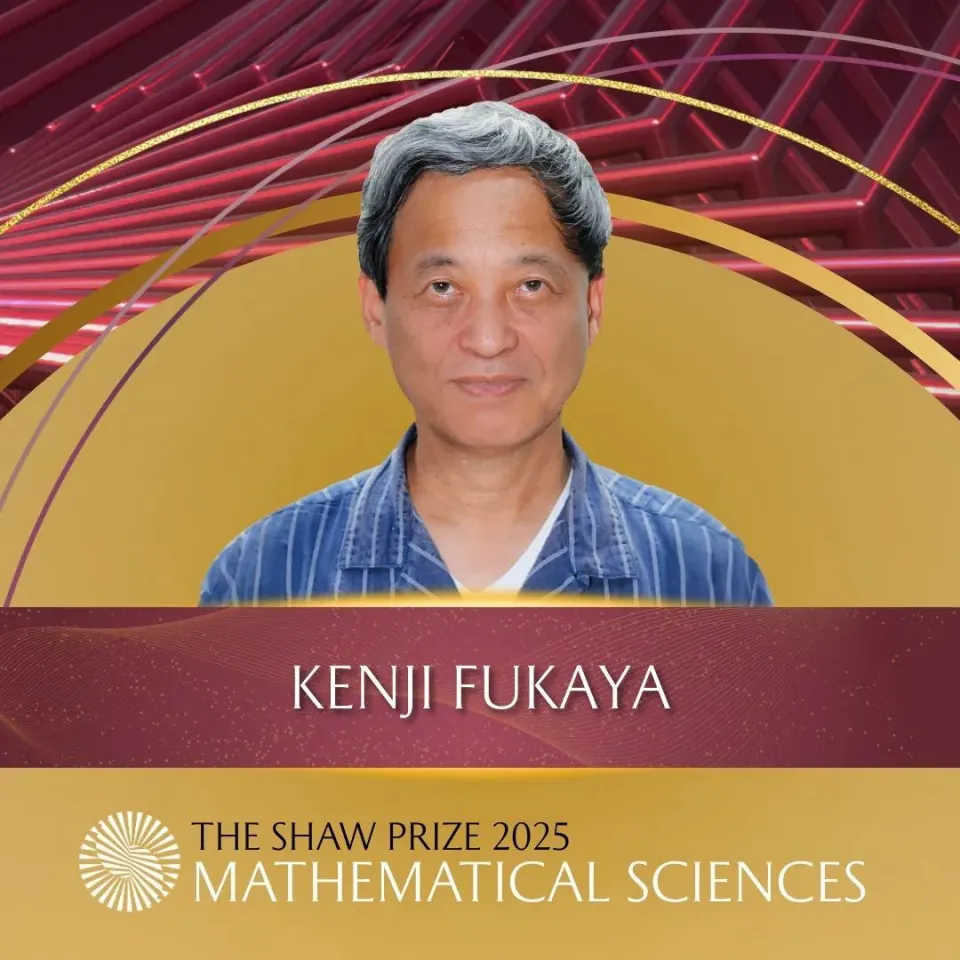Prof. Kenji Fukaya Awarded the 2025 Shaw Prize in Mathematical Sciences
28th May, 2025
On May 27, the Shaw Prize for 2025 was announced in Hong Kong. Professor Kenji Fukaya of the Beijing Institute of Mathematical Sciences and Applications (BIMSA)and the Yau Mathematical Sciences Center (YMSC) at Tsinghua University was awarded the Shaw Prize in Mathematical Sciences in recognition of his pioneering work in symplectic geometry, particularly for foreseeing the existence of what is now known as the "Fukaya category"—a concept composed of Lagrangian submanifolds in symplectic manifolds. He led and completed the monumental task of constructing this category and subsequently made groundbreaking and far-reaching contributions to symplectic topology, mirror symmetry, and gauge field theory.
At the press conference, Professor Hélène Esnault, Chair of the Shaw Prize Selection Committee for Mathematical Sciences, explained that in classical mechanics, the time evolution of a physical system is described as a flow in phase space determined by a Hamiltonian function. In the 1960s, Vladimir Arnold proposed a series of conjectures aimed at studying the lower bounds on the number of periodic solutions of this flow when the Hamiltonian is time-periodic. In modern mathematics, phase space has been generalized to symplectic manifolds. A refined conjecture concerns the lower bounds on the number of intersection points between two Lagrangian submanifolds in a symplectic manifold.
In the 1980s, building upon ideas from infinite-dimensional Morse theory, Andreas Floer pioneered Lagrangian Floer theory as an approach to tackle the Arnold conjecture. Under certain assumptions about symplectic manifolds and Lagrangian submanifolds, Floer constructed Floer homology from the solution space (serving as a moduli space) of a nonlinear partial differential equation, and successfully applied it to prove the Arnold conjecture in several special cases. However, without these assumptions, the moduli space could become extraordinarily complicated and singular, rendering the proof of the general Arnold conjecture profoundly challenging.
Fukaya and his collaborators jointly established and significantly expanded Lagrangian Floer theory, marking one of his most seminal contributions to mathematics.
Around 1993, building upon the concept of Morse homotopy, Fukaya discovered a higher-order algebraic structure within complex moduli spaces and proposed an ambitious vision: to endow arbitrary symplectic manifolds with an A-∞ category — what is now known as the "Fukaya category."
At that time, most of the necessary tools to realize this vision were still lacking. One of the primary challenges lay in handling the singularities of moduli spaces. Fukaya introduced and developed the theory of Kuranishi structures with his collaborators to establish a novel approach, attaching virtual fundamental chains to singular spaces equipped with Kuranishi structures and constructing an intersection theory for these chains. Through their collective efforts, they surmounted profound technical obstacles, establishing what is now regarded as a landmark achievement in mathematics.
The Fukaya category is not only intrinsically beautiful but also serves as a powerful tool in symplectic topology. Indeed, Fukaya and his collaborators achieved novel results on the non-displaceability of specific Lagrangian submanifolds and constructed new quasi-morphisms on Hamiltonian diffeomorphism groups of certain symplectic manifolds.
The Fukaya category has attracted widespread attention from mathematicians across diverse fields, due in significant part to Maxim Kontsevich's homological mirror symmetry conjecture. This conjecture posits an equivalence between the Fukaya category of a Calabi-Yau manifold and the derived category of coherent sheaves on its mirror manifold. Fukaya made revolutionary contributions to the development of mirror symmetry, notably through his initiation of the family Floer homology program.
Fukaya's early work made significant contributions to Riemannian geometry and gauge field theory. Recently, in collaboration with other researchers, he achieved groundbreaking progress on the Atiyah-Floer conjecture concerning Floer homology for three-dimensional manifolds using Lagrangian Floer theory. Notably, this very conjecture was among the primary motivations that originally led him to propose the Fukaya category.

Kenji Fukaya obtained his Bachelor's degree in Mathematics from the University of Tokyo in 1981 and earned his Ph.D. from the same institution in 1986 under the supervision of renowned Japanese mathematician Akio Hattori. From 1983 to 1993, he held positions as a Research Assistant and later Associate Professor at the University of Tokyo. In 1994, he was appointed Professor of Mathematics at Kyoto University. Fukaya became a permanent member of the Simons Center for Geometry and Physics at Stony Brook University in 2013. In the fall semester of 2024, he joined Tsinghua University's Yau Mathematical Sciences Center and the Beijing Institute of Mathematical Sciences and Applications as a full-time professor.

Professor Fukaya has received numerous prestigious awards in mathematics, including:
• The Geometry Prize from the Mathematical Society of Japan (1989)
• The Inoue Prize for Science (2002)
• The Japan Academy Prize (2003)
• The Asahi Prize (2009)
• The Fujiwara Prize (2012)
Professor Shing-Tung Yau once remarked that Heisuke Hironaka, Shigefumi Mori, Kenji Fukaya, and Masaki Kashiwara are among Japan's most celebrated mathematicians of our time. Professor Fukaya initially focused his research on Riemannian geometry in his early career before shifting to symplectic geometry in the 1990s. He has made outstanding contributions to both fields, with his work in symplectic geometry proving particularly influential—providing powerful tools for low-dimensional topology, mirror symmetry, and related areas. His research is not only highly original but has also fundamentally “reshaped the frontiers of geometry”.

The Shaw Prize was established according to the wishes of Sir Run Run Shaw and is awarded annually to recognize scientists who have recently achieved groundbreaking results in academic and scientific research or applications, with profound impacts on human life. The inaugural award ceremony was held in Hong Kong in 2004.
To date, the Shaw Prize in Mathematical Sciences has been successfully conferred for 21 editions, with a total of 32 mathematicians honored. Professor Shiing-Shen Chern, the father of modern differential geometry, received the inaugural Shaw Prize in Mathematical Sciences. Renowned mathematicians and Fields Medalists, including Andrew Wiles, David Mumford, and Maxim Kontsevich, have also been awarded this distinguished honor. In 2023, Professor Shing-Tung Yau, Chair Professor at Tsinghua University and Academician, was honored with this prize.

The official website for the Shaw Prize Foundation states: "Mathematics is the foundational language of all sciences. Its 20th-century advances—solving ancient problems and birthing new fields—have permeated every branch of creative science and technology. In this digital and computational age of the 21st century, the role it plays in the world will only grow."




